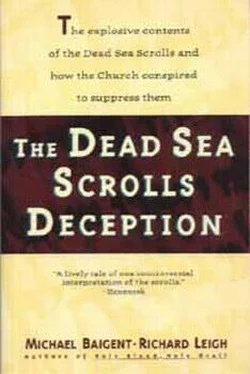In the conflict between James and Paul, the emergence and evolution of what we call Christianity stood at a crossroads. Had the mainstream of its development conformed to James’s teachings, there would have been no Christianity at all, only a particular species of Judaism which might or might not have emerged as dominant. As things transpired, however, the mainstream of the new movement gradually coalesced, during the next three centuries, around Paul and his teachings. Thus, to the undoubted posthumous horror of James and his associates, an entirely new religion was indeed born — a religion which came to have less and less to do with its supposed founder.
13. James ‘The Righteous’
If James played so important a role in the events of the time, why do we know so little about him? Why has he been relegated to the status of a shadowy figure in the background? Those questions can be answered simply enough. Eisenman stresses that James, whether he was literally Jesus’ brother or not, had known Jesus personally in a way that Paul never did. In his teachings, he was certainly closer to ‘the source’ than Paul ever was. And his objectives and preoccupations were often at variance with Paul’s — were sometimes, indeed, diametrically opposed. For Paul, then, James would have been a constant irritant. With the triumph of Pauline Christianity, therefore, James’s significance, if it couldn’t be obliterated completely, had, at the very least, to be diminished.
Unlike a number of personalities in the New Testament, James does seem to have been an historical personage, and, moreover, one who played a more prominent role in the affairs of his time than is generally recognised. There is, in fact, a reasonably copious body of literature pertaining to James, even though most of it lies outside the canonical compilation of the New Testament.
In the New Testament itself, James is mentioned in the Gospels as one of Jesus’ brothers, though the context is generally vague or confusing and has obviously been tampered with. In Acts, as we have discussed, he assumes rather more prominence, though it is not until the second part of Acts that he emerges in any kind of perspective. Then, with Paul’s letter to the Galatians, he is clearly identified as the leader of the ‘early Church’, who resides in Jerusalem and is attended by a council of elders. 1Apart from those that impinge on Paul, however, one learns little of his activities, and even less about his personality and biography. Neither is the Letter of James in the New Testament of much value in this respect. The letter may indeed derive from a text by James, and Eisenman has drawn attention to its Qumranic style, language and imagery. 2It contains (James 5:6) an accusation whose significance will become apparent shortly — an accusation to the effect that ‘you murdered the righteous [or just] man’. 3Again, however, no personal information is vouchsafed.
Such is James’s role in scripture proper. But if one looks further afield, a portrait of James does begin to emerge. This is the research which Eisenman has been pursuing over the last few years. One source of information he has emphasised is an anonymous text of the ‘early Church’, the so-called ‘Recognitions of Clement’, which surfaced very early in the 3rd century. According to this document, James is preaching in the Temple when an unnamed ‘enemy’, accompanied by an entourage of followers, bursts in. The ‘enemy’ taunts James’s listeners and drowns out his words with noise, then proceeds to inflame the crowd ‘with revilings and abuse, and, like a madman, to excite everyone to murder, saying “What do ye? Why do ye hesitate? Oh, sluggish and inert, why do we not lay hands upon them, and pull all these fellows to pieces?”’ 4The ‘enemy’ does not confine himself to a verbal assault. Seizing a brand of wood, he begins to flail about with it at the assembled worshippers, and his entourage follow suit. A full-scale riot ensues:
Much blood is shed; there is a confused flight, in the midst of which that enemy attacked James, and threw him headlong from the top of the steps; and supposing him to be dead, he cared not to inflict further violence upon him. 5
James, however, is not dead. According to the ‘Recognitions’, his supporters carry him back to his house in Jerusalem. The next morning, before dawn, the injured man and his supporters flee the city, making their way to Jericho, where they remain for some time — presumably while James convalesces. 6
For Eisenman, this attack on James is pivotal. He notes the parallels between it and the attack on Stephen as recounted in Acts. He suggests that Stephen may be an invented figure, to disguise the fact that the attack — as Acts could not possibly have admitted — was really directed at James. And he points out that Jericho, where James flees for refuge, is only a few miles from Qumran. What is more, he argues, the flight to Jericho has a ring of historical truth to it. It is the kind of incidental detail that is unlikely to have been fabricated and interpolated, because it serves no particular purpose. As for the ‘enemy’, there would seem to be little doubt about his identity. The ‘Recognitions of Clement’ concludes:
Then after three days one of the brethren came to us from Gamaliel… bringing us secret tidings that the enemy had received a commission from Caiaphas, the chief priest, that he should arrest all who believed in Jesus, and should go to Damascus with his letters… 7
The surviving editions of Josephus’ Antiquities of the Jews contain only one reference to James, which may or may not be later interpolation. The chronicle reports that the Sanhedrin, the religious high court, call before them James, ‘the brother of Jesus who was called Christ’. 8Accused (most improbably) of breaking the Law, James and certain of his companions are found guilty and accordingly stoned to death. Whether this account is accurate, doctored or wholly invented, the most important aspect of it is the date to which it refers. Josephus indicates that the events he has described occurred during an interval between Roman procurators in Judaea. The incumbent procurator had just died. His successor, Lucceius Albinus, was still en route to Palestine from Rome. During the interregnum, effective power in Jerusalem was wielded by the high priest, an unpopular man named Ananas. This allows the account of James’s death to be dated at around ad 62 — only four years before the outbreak of the revolt in ad 66. Here, then, is at least some chronological evidence that James’s death may have had something to do with the war that ravaged the Holy Land between ad 66 and 73. For further information, however, one must turn to later Church historians.
Perhaps the major source is Eusebius, 4th-century Bishop of Caesarea (the Roman capital of Judaea) and author of one of the most important early Church histories. In accordance with the conventions of the time, Eusebius quotes at length from earlier writers, many of whose works have not survived. In speaking of James, he cites Clement, Bishop of Alexandria (c. ad 150-215). Clement refers to James, we are told, as ‘the Righteous’, or, as it is often translated, ‘the Just’ — ‘ Zaddik’ in Hebrew. 9This, of course, is the by now familiar Qumranic usage, whence derives the ‘Teacher of Righteousness’, the leader of the Qumran community. According to Clement, Eusebius reports, James was thrown from a parapet of the Temple, then beaten to death with a club. 10
Later in his chronicle, Eusebius quotes extensively from a 2nd-century Church historian, Hegesippus. All of Hegesippus’ works were reputedly extant as late as the 16th or 17th century. Everything has since disappeared, though copies may well exist in the Vatican, as well as in the library of one or another monastery — in Spain, for example. 11At present, however, almost everything we have by Hegesippus is contained in the excerpts from his work cited by Eusebius.
Читать дальше












